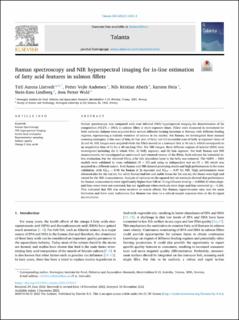| dc.contributor.author | Lintvedt, Tiril Aurora | |
| dc.contributor.author | Andersen, Petter Vejle | |
| dc.contributor.author | Afseth, Nils Kristian | |
| dc.contributor.author | Heia, Karsten | |
| dc.contributor.author | Lindberg, Stein-Kato | |
| dc.contributor.author | Wold, Jens Petter | |
| dc.date.accessioned | 2022-12-08T13:40:22Z | |
| dc.date.available | 2022-12-08T13:40:22Z | |
| dc.date.created | 2022-12-05T13:39:22Z | |
| dc.date.issued | 2022 | |
| dc.identifier.citation | Talanta: The International Journal of Pure and Applied Analytical Chemistry. 2023, 254. | en_US |
| dc.identifier.issn | 0039-9140 | |
| dc.identifier.uri | https://hdl.handle.net/11250/3036820 | |
| dc.description.abstract | Raman spectroscopy was compared with near infrared (NIR) hyperspectral imaging for determination of fat composition (%EPA + DHA) in salmon fillets at short exposure times. Fillets were measured in movement for both methods. Salmon were acquired from several different farming locations in Norway with different feeding regimes, representing a realistic variation of salmon in the market. For Raman, we investigated three manual scanning strategies; i) line scan of loin, ii) line scan of belly and iii) sinusoidal scan of belly at exposure times of 2s and 4s. NIR images were acquired while the fillets moved on a conveyor belt at 40 cm/s, which corresponds to an acquisition time of 1s for a 40 cm long fillet. For NIR images, three different regions of interest (ROI) were investigated including the i) whole fillet, ii) belly segment, and iii) loin segment. For both Raman and NIR measurements, we investigated an untrimmed and trimmed version of the fillets, both relevant for industrial in-line evaluation. For the trimmed fillets, a fat rich deposition layer in the belly was removed. The %EPA + DHA models were validated by cross validation (N = 51) and using an independent test set (N = 20) which was acquired in a different season. Both Raman and NIR showed promising results and high performances in the cross validation, with R2CV = 0.96 for Raman at 2s exposure and R2CV = 0.97 for NIR. High performances were obtained also for the test set, but while Raman had low and stable biases for the test set, the biases were high and varied for the NIR measurements. Analysis of variance on the squared test set residuals showed that performance for Raman measurements were significantly higher than NIR at 1% significance level (p = 0.000013) when slope-and-bias errors were not corrected, but not significant when residuals were slope-and-bias corrected (p = 0.28). This indicated that NIR was more sensitive to matrix effects. For Raman, signal-to-noise ratio was the main limitation and there were indications that Raman was close to a critical sample exposure time at the 2s signal accumulation. | |
| dc.language.iso | eng | en_US |
| dc.subject | Representative sampling | |
| dc.subject | Representative sampling | |
| dc.subject | In line food evaluation | |
| dc.subject | In-line food evaluation | |
| dc.subject | NIR hyperspectral Imaging | |
| dc.subject | NIR hyperspectral Imaging | |
| dc.subject | Salmon quality | |
| dc.subject | Salmon quality | |
| dc.subject | Ramanspektroskopi | |
| dc.subject | Raman spectroscopy | |
| dc.title | Raman spectroscopy and NIR hyperspectral imaging for in-line estimation of fatty acid features in salmon fillets | en_US |
| dc.title.alternative | Raman spectroscopy and NIR hyperspectral imaging for in-line estimation of fatty acid features in salmon fillets | en_US |
| dc.type | Journal article | en_US |
| dc.type | Peer reviewed | en_US |
| dc.description.version | publishedVersion | |
| dc.source.volume | 254 | en_US |
| dc.source.journal | Talanta: The International Journal of Pure and Applied Analytical Chemistry | en_US |
| dc.identifier.doi | 10.1016/j.talanta.2022.124113 | |
| dc.identifier.cristin | 2088787 | |
| dc.relation.project | Norges forskningsråd: 309259 | |
| dc.relation.project | Norges forskningsråd: 296083 | |
| dc.relation.project | Norges forskningsråd: 314111 | |
| cristin.ispublished | true | |
| cristin.fulltext | original | |
| cristin.qualitycode | 1 | |
